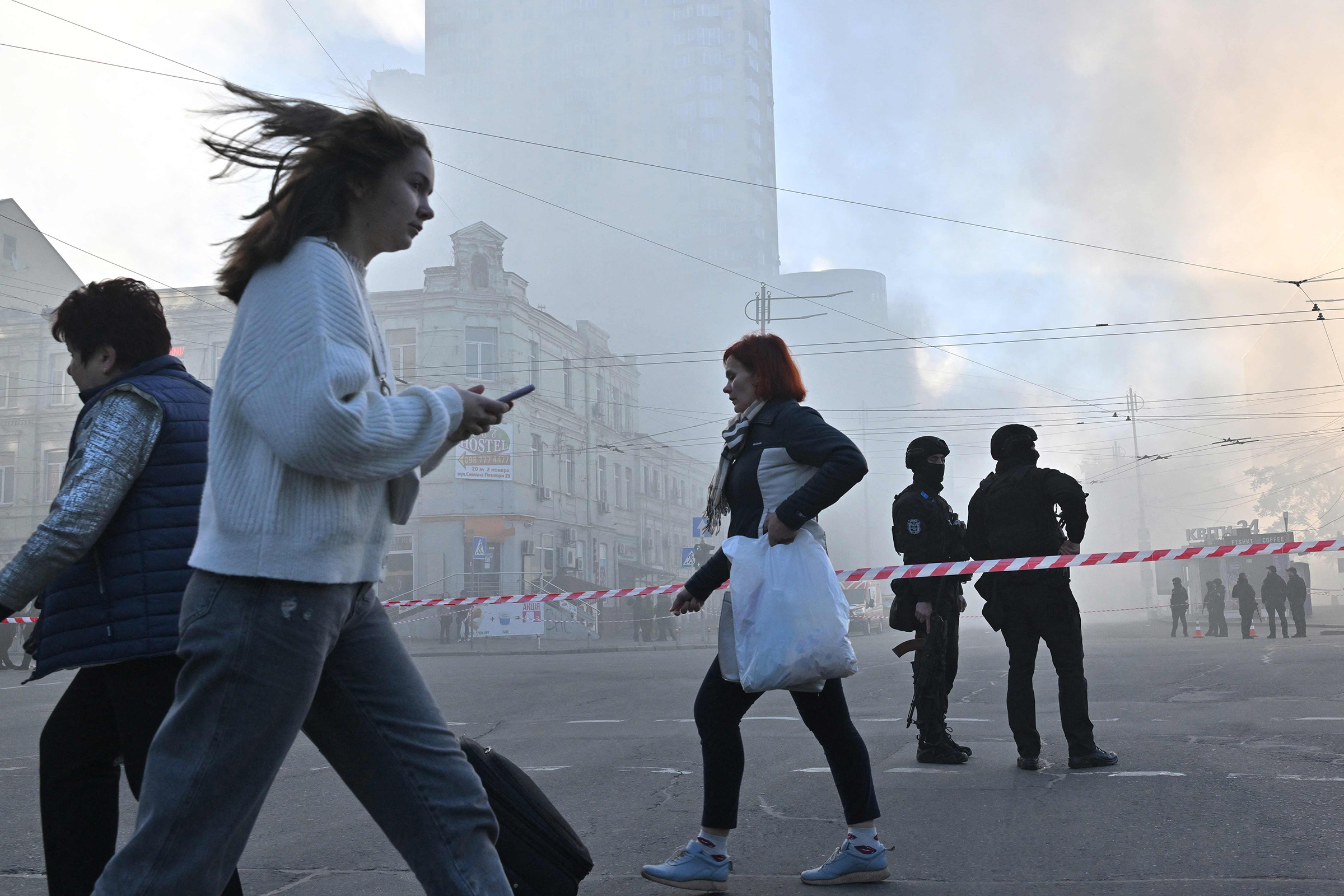As scenes of firefighters flocking to the wreckage in Ukraine’s capital, Kyiv, emerged in the aftermath of a Russian drone attack earlier this week, the type of drone that was used to cause this destruction has sparked a debate about the state of play in the ongoing war.
Does the increasing deployment of Iranian Shahed-136 drones—popularly known as kamikaze drones—that are launched from a distance and explode on impact, show strength or desperation from Russian forces?
Shahed-136 drones have a triangular wing and dive toward a target carrying a warhead of around 80 pounds. The small cruise missiles are typically launched from the back of a flatbed truck and have a range of up to 1,500 miles.
The uncrewed aerial vehicles (UAVs) were first spotted in Ukraine two months ago, when they were used to destroy a U.S-supplied M777 howitzer that was being used by the Ukrainian military. Experts take this as a sign that Russia is lacking precision-guided missiles that can target the howitzers that Ukraine has deployed to great effect. But it also shows that Russian ties with Iran remain strong, despite Tehran denying that it supplied them.
Below, here’s what to know about the drones.
Why is Russia using Shahed-136s?
The Shahed-136 is an autonomous weapon that affords Russia the ability to inflict damage to Ukrainian infrastructure and civilian targets without direct risk to military personnel. Additionally, Russia may be resorting to new weapons if it has used up the majority of its guided missiles.
Oleksii Reznikov, the Ukrainian Minister of Defense, estimated on Oct. 14 that Russia only has 124 out of 900 medium-range Iskanders left, just over half its Kalibr missiles, and less than half its air-launched cruise missiles. Reznikov wrote: “By using hundreds of high-precision missiles against civilian objects of Ukraine, the aggressor state reduces its ability to strike the military targets.”
Drones are not a new addition to the conflict, as Ukraine has also used drones throughout the war. The nation has deployed Turkish-made Bayraktar TB2 drones, which are lightweight with a 12-meter (40-feet) wingspan and can each carry four laser-guided missiles. They have also been provided with Switchblade loitering munitions by the U.S., which are able to use a drone’s thermal and daylight cameras to locate a target and destroy it.
Read More: Ukraine’s Secret Weapon Against Russia: Turkish Drones
Where have the autonomous weapons been deployed?

The first use of Shahed-136 drones in Ukraine took place in August in the northeast of the country and was tested on Ukrainian artillery. Since then, critical infrastructure has been targeted with drones attacking Dnipro, Sumy, Bila Tserkva, and Kyiv, resulting in power cuts in many residential towns and villages.
At least eight people have died as a result of kamikaze drones across Ukraine, including a young couple in Kyiv who were expecting their first child. Drone attacks on Monday also targeted the headquarters of Ukraine’s national energy utility in the capital and damaged homes; around 18 people were freed from the rubble of a collapsed apartment building in the capital.
Ukrainian forces continue to shoot down the Shahed-136 drones, claiming a 60% success rate. Britain’s Ministry of Defense said, “There is a realistic possibility that Russia has achieved some success by attacking with several UAVs at the same time.”
Why is Iran supplying kamikaze drones?
The Iranian supply of weapons to Russia suggests a deepening of ties between Tehran and the Kremlin. On Tuesday, Iran denied selling drones to Russia but doubled down on its right to sell arms to other nations as any restrictions imposed by the 2015 Iran nuclear deal––whereby Iran agreed to halt its nuclear program in exchange for sanctions relief––ceased to have jurisdiction in 2020.
Moving away from future prospects of improving relations with the West, Iran appears to be redirecting its ally-ship toward China and Russia. Vladamir Putin was seen visiting Iranian President Ebrahim Raisi in Tehran in June, and they met once again in September at the Shanghai Cooperation Organisation to progress a new trade and security treaty.
How has the international community reacted?
The U.S State Department along with other Western allies have said that Iran’s supply of drones to Russia violates U.N. Security Council Resolution 2231. At a NATO conference last week, it was announced that the West would send more arms in response to escalating Russian attacks in Ukraine, including the kamikaze drones.
On Wednesday, officials and diplomats told the Associated Press that the European Union was finalizing a list of sanctions to swiftly impose on Iran for supplying the drones. The anonymous officials told the news agency this would likely include an asset freeze on one “entity”––often a government agency, company, or other organization––in addition to asset freezes and travel bans for individuals linked to the drone sector.
Israel has maintained a strategically neutral position since Russia’s invasion of Ukraine began last February. The nation has provided Ukraine with humanitarian assistance but resisted requests for military equipment and pressure to enforce strict economic sanctions on Russia. But there is now very real potential for Israel to take a more explicit stance on the conflict in light of Russia’s partnership with Iran, whom Israel has long regarded as an enemy.
More Must-Reads from TIME
- Cybersecurity Experts Are Sounding the Alarm on DOGE
- Meet the 2025 Women of the Year
- The Harsh Truth About Disability Inclusion
- Why Do More Young Adults Have Cancer?
- Colman Domingo Leads With Radical Love
- How to Get Better at Doing Things Alone
- Michelle Zauner Stares Down the Darkness
Write to Armani Syed at armani.syed@time.com
